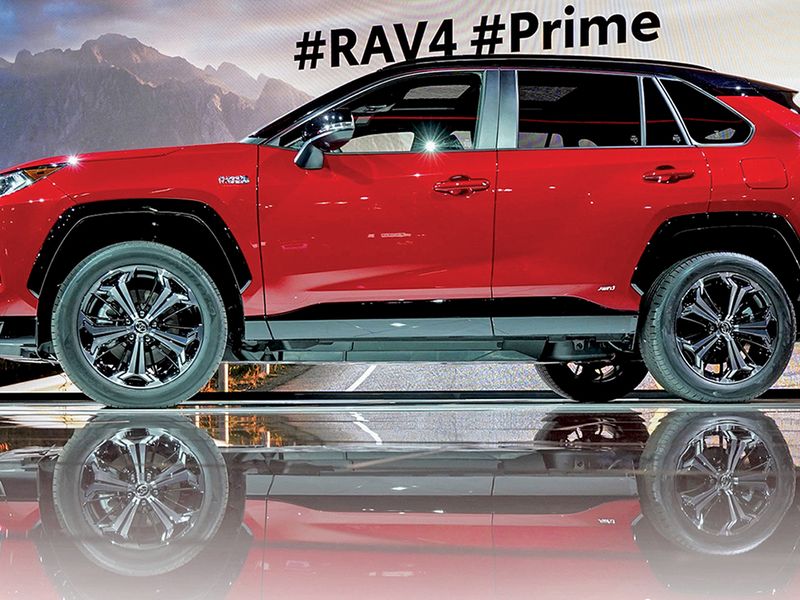
Toyota’s decision to add at least a third plug-in hybrid nameplate to its U.S. lineup next year bucks an industry trend that has seen other automakers pull back their PHEV offerings as full battery-electric vehicles proliferate.
The industry fall-off in plug-ins might be because of the vehicles’ added cost and complexity or the fact that regulators don’t seem to value them as much as full BEVs. But Toyota, sticking to its pioneering hybrid technology, sees plug-ins as part of a broader overall strategy that seeks to cut carbon emissions sooner before full EV charging infrastructure is in place.
A presentation from its chief scientist indicates that Toyota sees a case for expanding plug-ins to several different types of vehicles — which means the U.S. could see more plug-in hybrids on roads in coming years.
The automaker promised last month to add a third plug-in hybrid to its lineup next year, though details of what model will join the Prius Prime and RAV4 Prime PHEVs were not revealed. The Japanese automaker will also add two battery-electric vehicles — one will be an SUV or crossover, and onewill be Toyota -branded.
The three new vehicles are part of Toyota’s broader strategy to become what Toyota Motor North America sales head Bob Carter called “the Macy’s department store” of automotive powertrains to cut greenhouse gas emissions.
An analysis by Gill Pratt, Toyota’s top scientist, argues that plug-in hybrids offer one of the best overall returns for automakers to reduce carbon emissions, especially for consumers who have access to a plug and have average commutes. His analysis, shared with the media last month, seemed to advocate for an additional plug-in hybrid sedan and crossover as Toyota’s most attractive option for cutting emissions.
“Not only do plug-in hybrid vehicles perform extremely well in reducing carbon emissions, but actually even hybrid vehicles do remarkably well when you consider them in the context of other vehicles, including full battery-electric vehicles,” Pratt said. “Most of the time, if these vehicles are used for commuting, they’re being used in the battery-electric mode, and only occasionally does the engine run in those cars.”
While they might make sense scientifically or as part of a bigger strategy, PHEVs do have their drawbacks.
No matter which energy source it’s using at any given moment to propel itself, a plug-in hybrid is essentially hauling the other portion around as dead weight, explains Sam Abuelsamid, principal analyst leading e-mobility research with Guidehouse Insights.
“Pricing is a challenge. PHEVs are going to be significantly more expensive than just a standard hybrid, primarily because you have a bigger battery, plus you also need a more powerful motor, more powerful electronics,” said Abuelsamid, a former automotive engineer. “Architecturally, they’re largely the same as a conventional hybrid, but to really benefit from it, you have to up-size things like the motors and the power electronics so you can actually drive it on electricity alone.”
That bears out with Toyota’s two current PHEVs. The Prius Prime, introduced in 2016 and with a battery-only range of 25 miles, starts at $29,215, including shipping, a $3,695 premium over the Prius hybrid. The RAV4 Prime, which went on sale last year, can drive 42 miles on battery alone, and it starts at $39,275, a $9,450 premium over the RAV4 Hybrid.
Toyota sold 14,698 Prius Primes in 2020 in the U.S., down 33 percent from 2019, while the automaker sold 3,200 RAV4 Primes in its first year on the market.
While automakers have begun flooding the market with high-profile BEVs, the number of plug-in hybrids is shrinking.
According to the U.S. Department of Energy’s Alternative Fuels Data Center, automakers offered 47 PHEVs for the 2020 model year but just 35 in the 2021 model year.
Part of the reason might be the smaller regulatory benefit that PHEVs receive relative to full battery-electric vehicles, Abuelsamid said. Automakers can earn more than four times the zero-emission vehicle credits per vehicle for each battery-electric they manufacture vs. a comparable plug-in hybrid. Said Abuelsamid: “For companies like [Stellantis], which doesn’t have BEVs on the market, or Toyota, whose only ZEV is the Mirai [hydrogen fuel cell vehicle], they can at least earn some credits selling PHEVs.”